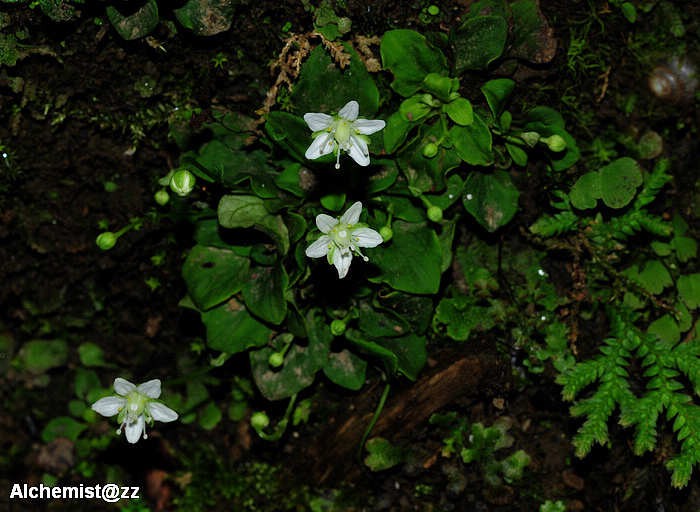峨眉梅花草 Parnassia faberi
- Scientific Name: Parnassia faberi Oliv.
- Ref: Hooker’s Icon. Pl. 18: t.1778. 1888
- Synonym: Parnassia petitmenginii H.Lév.
- Chinese Common Name: 峨眉梅花草 Éméi méihuā∙cǎo
- Family: Celastraceae
- Genus: Parnassia
- Distribution: Moist shaded forest understories, moist rocky places, roadsides; 1100-1900 m. C Sichuan (Emei Shan, Mabian Xian), NE Yunnan (Yiliang Xian).
- Photo: 07/26/2012, Mt. Emei, Sichuan
Stems 2 or 3, short or occasionally branched and elongate, 5-8 cm, with 1 leaf near middle. Basal leaves numerous; petiole 5-8 mm; leaf blade abaxially greenish, adaxially purple-green, broadly ovate, broadly rhomboid-ovate, or broadly obovate, 0.6-1.5 cm × 5-14 mm, base cuneate, apex rounded or obtuse, sometimes apiculate. Cauline leaf sessile, semiamplexicaul, oblong or obovate, sometimes rhomboid, 2-3 mm, base often with a few rusty brown appendages. Flower ca. 1 cm in diam.; hypanthium inconspicuous. Sepals purple punctate, ovate-lanceolate, oblong, or elliptic, 4-5 × 2-3 mm, margin entire, apex obtuse. Petals white, indistinctly punctate, obovate-oblong, 3-5 × ca. 3 mm, 3-veined, base abruptly contracted into a stalk ca. 0.5 mm, margin entire, apex acuminate. Anthers ellipsoid, ca. 0.5 mm; filaments ca. 0.5 mm; staminodes with stalk ca. 2 mm, lamina turgid distally, 2-lobed and 2-labiate, abaxial lobe entire, adaxial lobe 2- or 3-lobed. Ovary superior, ovoid or ellipsoid; stigma 3-lobed, lobes ovate. Capsule subglobose. Seeds brown, glossy, oblong. Fl. Jul-Sep, fr. Sep. (Flora of China)

07/26/2012, Mt. Emei, Sichuan
